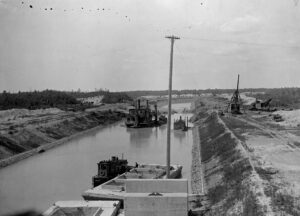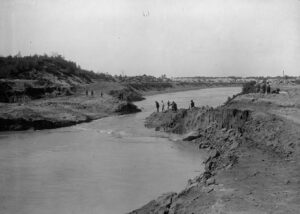A Century of the Trent-Severn Waterway
The year 2020 marks one hundred years since the Trent-Severn Waterway was completed. On the morning of 23 June 1920, a dynamite blast in the Couchiching Canal removed the last obstacle for navigation between Lake Ontario and Georgian Bay. Eighty-seven years after the construction of its first lock at Bobcaygeon, “The Waterway” was truly open.
The idea of a water connection between the upper and lower Great Lakes was considered seriously after the War of 1812 because the British military in Kingston, Montreal, and York  had found supplying and reinforcing garrisons and forces on Georgian Bay and Lake Huron difficult. Because it took so long to complete, the Trent-Severn’s military value was nullified – although during World War 2, seven Orillia-built Fairmile patrol boats used it to reach southern Canadian shipyards for arming and commissioning.
had found supplying and reinforcing garrisons and forces on Georgian Bay and Lake Huron difficult. Because it took so long to complete, the Trent-Severn’s military value was nullified – although during World War 2, seven Orillia-built Fairmile patrol boats used it to reach southern Canadian shipyards for arming and commissioning.
The Trent Canal, as it was named originally, was built in divisions – from the middle (the Bobcaygeon, Buckhorn, Burleigh, and Fenelon Falls locks) outward. Second came the Peterborough-Lakefield Division, followed by the Simcoe-Balsam Lake and Ontario-Rice Lake divisions; last was the Couchiching-Port Severn Division.
Without a military necessity for the waterway, the Canal was proposed as a barge route for hauling western grain from Georgian Bay ports to southern Canada. By 1900, railways had  already joined Lake Ontario and Georgian Bay. This left recreational boating and tourism as the only role for the water route. One reason for even finishing the project was that too much money had been spent to leave it uncompleted.
already joined Lake Ontario and Georgian Bay. This left recreational boating and tourism as the only role for the water route. One reason for even finishing the project was that too much money had been spent to leave it uncompleted.
Not a lot of boaters navigate the entire length of the Trent-Severn Waterway, but there is considerable localized traffic all along it. Thousands of people go over the Peterborough and Kirkfield lift locks annually – many just for the novelty, but others enroute to somewhere along the system. Every few years Americans in large boats traverse the Waterway as part of “The Loop” – a trip from the Gulf of Mexico to Lake Huron and down the Mississippi River.
However one relates to the Trent-Severn Waterway, we can all wish this grand lady “Happy Birthday” in 2020.
By: Don Willcock
Peterborough Museum & Archives, 300 Hunter St E. Peterborough 705-743-5180
www.peterboroughmuseumandarchives.ca




